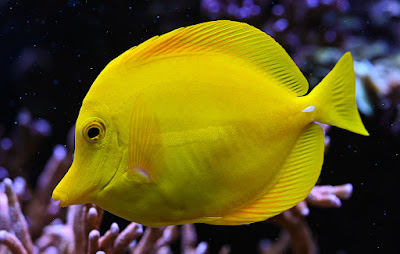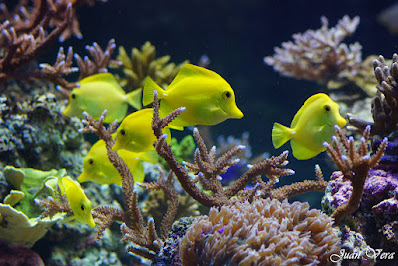Yellow tang is a very popular marine fish and brightens any marine system with its oval-shaped, vibrant yellow body.
Yellow tang, and its scientific name Zebrasoma flavescens, is popular among novice hobbyists, although many experienced hobbyists cherish the species as well. They brightens any marine system with its oval-shaped, vibrant yellow body.
YELLOW TANG - ZABRASOMA FLAVESCENS DESCRIPTION
Yellow tang is found in the central and western Pacific from the Hawaiian Islands and Johnston Island to the Marshall Islands, Wake, Mariana Islands, Philippines, Ogasawara and Ryukyu Islands, Japan. They inhabit coral-rich areas, both in protected lagoon waters and along seaward reefs, down to 50 m depth. When they reach sexual maturity, adults leave the deeper coral reef areas for shallower reef habitat.
Zebrasoma flavescens can grow up to 20 cm in length. They have a clear larval stage before developing into juveniles. Juveniles and adults have a narrow, oval-shaped, bright yellow body with long snouts and 7 fins including their spiny dorsal and anal fins. At night, this bright yellow color changes to a darker, grayer yellow with a white lateral line. They also have a sharp white spine on both sides of their tails which they can use to fight or defend themselves.
They exhibits sexual difference in growth. Males grow substantially faster than females from year 2 to 3, a trend that continues until the asymptotic size is approached. Sexual size dimorphism resulted from a higher growth rate for males through the juvenile period.
It is a long-lived species; they can live up to about 30 years on the reef and 10 years in captivity. Juveniles are often territorial. This trait usually diminishes as the fish mature and start to roam wider areas of the reef. Adult tangs live singly or in small, loose groups. During the day, they move from place to place, grazing on algae; at night, they generally rest alone in coral reef crevices.
YELLOW TANG - ZABRASOMA FLAVESCENS CARE
Yellow tang is suitable for reef aquariums (won’t eat corals and invertebrates) and can handle itself with semi-aggressive tank mates. They need a tank size of minimum 65 gallons with water temperature of 24 - 26 ºC, pH level of 8-8.4 and specific gravity of 1.020-1.026.
Zebrasoma flavescens are very aggressive towards fish with whom they compete for feeding requirements. They will fight with any yellow or similarly shaped fish so only house a single specimen. However, It is possible to keep a group of 5 or more in a very large tank if they are introduced simultaneously, and even then they will have to be closely monitored to ensure that no individuals are singled out and bullied.
It is one of the easiest of the tangs to keep. The key to keeping them healthy (a good indication is a solid belly and a glowing yellow colouration), is to ensure that their dietary needs are met. Handle these fish with caution as they have retractable spines at the base of the tail that can easily cause lacerations.
They are herbivores and in nature spend all day grazing algae off reef structures. In the aquarium their diet should consist of algae based foods such as nori, spirulina and frozen herbivore preparations which should be presented at least 3 times per day (young specimens will need more frequent feeding). It is beneficial to have a good covering of algae within the tank on which they can graze. They are also benefit from the odd meal of shrimp and other meaty marine foods and will also readily accept flakes and pellets.
YELLOW TANG - ZABRASOMA FLAVESCENS SPAWNING
Yellow tang can spawn in groups or in pairs. When in groups, females release eggs and males release sperm into open water where fertilization occurs. When in pairs, the male courts a female by changing colors and exhibiting a shimmering movement. The two fish then swim upward and simultaneously release their eggs or sperm into the water. Males may spawn with multiple females in one session, while females typically spawn only once a month.
Egg production follows a lunar pattern and peaks in spring and summer. Maximum batch fecundity was found to be around 24000 eggs. They do not guard their eggs, and once the eggs hatch the juveniles receive no parental care.
It is extremely difficult to breed these fish in captivity. Only since 2015 have researchers managed to keep a group of juvenile yellow tang alive past the larval stage. This achievement has significant potential for increasing the availability of this species.
BUY YELLOW TANG - ZABRASOMA FLAVESCENS AND RELATED PRODUCTS














COMMENTS